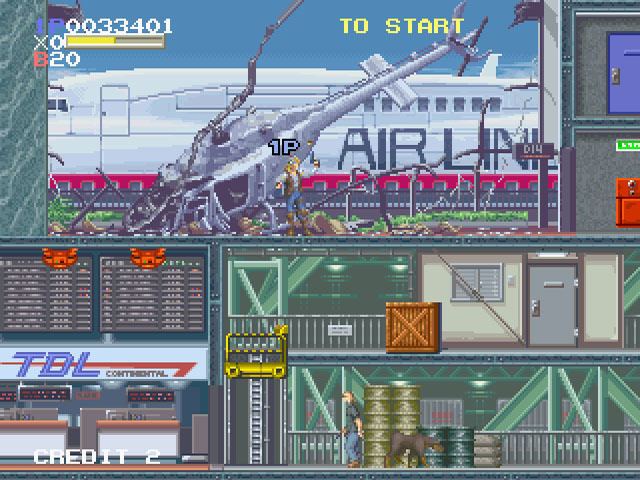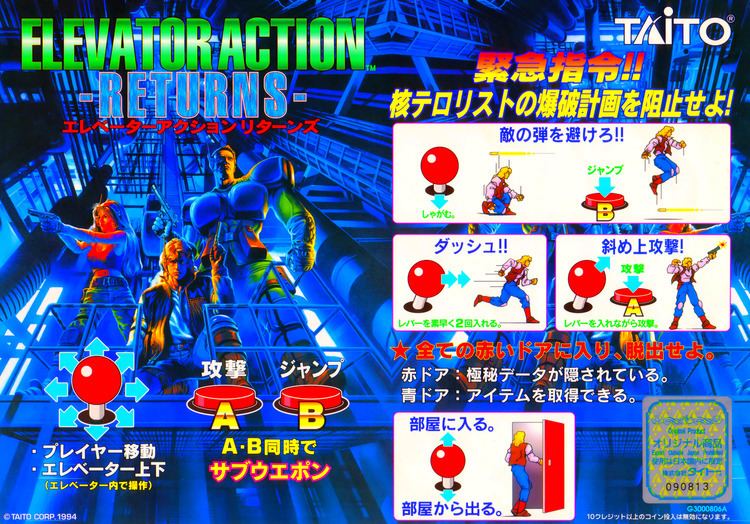7.4 /10 1 Votes7.4
5.2/10 GameSpot Cabinet Upright Initial release date 1995 | 4.7/5 Emuparadise Composer(s) Yasuhisa Watanabe Developer Taito Publishers Taito, Ving Co., Ltd. | |||||||||||||||||||||||||||||||||
 | ||||||||||||||||||||||||||||||||||
Designer(s) Yusuke TsudaKoji TeradaToshiyuki Takenami Release date(s) 1994 (Arcade)1997 (Saturn) Mode(s) Up to 2 players simultaneously Genres Action game, Platform game Similar Taito games, Platform games | ||||||||||||||||||||||||||||||||||
Elevator action returns 2 player arcade game 60fps
Elevator Action Returns (エレベーターアクション リターンズ), released as Elevator Action II in North America, is a side-scrolling action game by Taito Corporation originally released for the arcades in 1994 as a sequel to the 1983 arcade game Elevator Action. Elevator Action Returns retains the elevator-based gimmick from the original, but expands and improves on the gameplay system and replaces the spy motif with a new scenario involving a paramilitary team fighting against a terrorist group.
Contents
- Elevator action returns 2 player arcade game 60fps
- Elevator action returns mame arcade no deaths
- Gameplay
- Plot
- Characters
- Release
- Reception
- References

The mostly well-received game was ported to the Sega Saturn and released as a Japan-only title named Elevator Action² Returns in 1997, and later included in Taito Legends 2 compilation release for the PlayStation 2, Windows and Xbox in 2006.

Elevator action returns mame arcade no deaths
Gameplay

The controls consists of an eight-way joystick and two action buttons (shoot and jump). The objective of the game is to enter all the red-colored doors in each stages and then proceed to the exit. If the player misses a door, he or she will not be allowed to go any further after a certain point. Each player has a health gauge that shows the amount of damage that his or her character is allowed to sustain; when the gauge reaches zero, the player will lose a life. Many additions have also been made to the play mechanics thanks to the advancement in technology such as four-way scrolling (the original could only scroll vertically), new moves and weapons for the player, multiple characters and a two-players cooperative mode.
The player can uncover items by destroying objects in the scenery such as trash cans, garbage piles, sandbags and crates. There are also blue-colored doors that will the player a random item through a roulette drawing system. Items include health refills, special firearms, sub-weapons and bonus points. Like in the original game, the player's default weapon is a semi-automatic handgun with unlimited ammunition. However, the player has the option to upgrade to a stronger firearm as well, a missile launcher or an automatic weapon. If the ammo for either weapon runs out, the player will revert to the default handgun. However, if the player picks up a weapon of the same type he/she is currently wielding, then the ammunition of the new weapon is instead added to the current amount.
The player can conserve ammo by attacking an enemy at close range, causing he/she to use a melee attack instead of firing a weapon. When an enemy is defeated with a close-range attack, the amount of points awarded will be doubled. The player can also attack the enemy with a jumping attack depending on the timing. The player can also throw an explosive (which serves as the character's sub-weapon) by pressing the shoot and jump buttons simultaneously while standing or crouching. The type of explosive used by the player varies depending on the character. The player can use explosives to take down several enemies in a fixed range, allowing players to accumulate more points than by killing them with simple gunfire.
Objects in the environment can also be used to fight enemies. Like in the original game, elevators can be used to crush enemies standing above or below one. There are also oil drums that can be exploded with gunfire. Like the player's sub-weapons, they will leave a trail of fire that will burn off any enemy that comes in contact with it. Enemies that are killed by a trail of fire gives out more points. During the later half of the game, the player will also have to deal with electric barriers that will harm both players and enemies alike. If an enemy is killed with an electric barrier, the player will be awarded with additional points.
The player will lose a life depending on the following situations.
Plot
The player controls a member of special task force who must foil a terrorist group that has planted numerous nuclear bombs in various facilities. The player must obtain secret intelligence data scattered throughout each facility in order to disarm the bombs. There are six stages, consisting of a skyscraper, an airport, an underground arcade, a sewer, an underwater oil plant and a missile base.
Characters
The player can choose from the one of the following three characters when starting the game:
Release
A home version of Elevator Action Returns was released for the Sega Saturn in 1997 under the title of Elevator Action² Returns (pronounced Elevator Action/Elevator Action Returns), which included the original Elevator Action as well. Elevator Action Returns was later included as part of Taito Legends 2 for the PlayStation 2, PC and Xbox in 2006, but both the PS2 and Xbox versions run in upscanned 640x448 resolution, which results in slight flickering, no scanlines and slightly blurrier image compared to the arcade and Sega Saturn versions.
Reception
A 1997 import review by GameSpot gave it a score of 5.2/10, opining: "Elevator Action Returns is not a bad game, per se. But compared to what's out there, it's simply not worth the price of admission (around $60, on average, for an import). If it ever hits the States, it will be the perfect rental." Seventeen years later, Jeremy Parish of USgamer wrote "Elevator Action II was a game out of time. But it was well-made, if conceptually somewhat baffling, and like so many projects clearly borne of misguided enthusiasm it managed to be a lot of fun."
In a retrospective, Hardcore Gamer called Elevator Action Returns an "overlooked classic" and said it "deserves the same timeless honor and widespread acclaim as its classic 1983 predecessor." Darren Jones of Retro Gamer called in one of "many excellent 2D arcade hits never had a chance in the UK" and an "outstanding... fantastic sequel that totally blew away the original 1983 arcade hit" with gameplay features that "greatly improved upon those seen in the original game". Jones especially applauded its "superb visual style": "The many buildings that your agents explored were little more than derelict dumps that dripped with decay and graffiti; while your opponents looked like they'd just jumped from the frames of a 2000AD comic strip. And the violence... Bodies erupted in showers of blood, torched enemies writhed about in agony; the incredible animation simply elevated (sorry) the on-screen chaos to a beautiful ballet of mayhem that would have made John Woo proud. Best of all, the Saturn conversion was utterly flawless and even included the original game."
In 2005, IGN listed the "arcade-perfect" Saturn port among the best classic co-op games. Retro Gamer included it on their list of ten essential Saturn imports: "It's a wonderfully slick run-and-gun with gritty looking visuals, well-animated enemies and plenty of variety in its stages," as well as "an excellent co-op mode."
